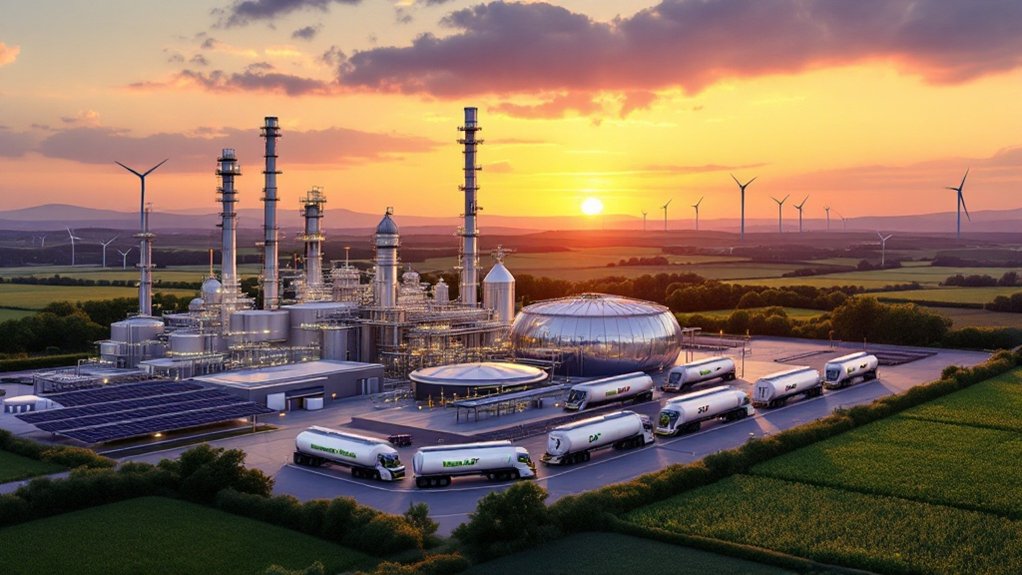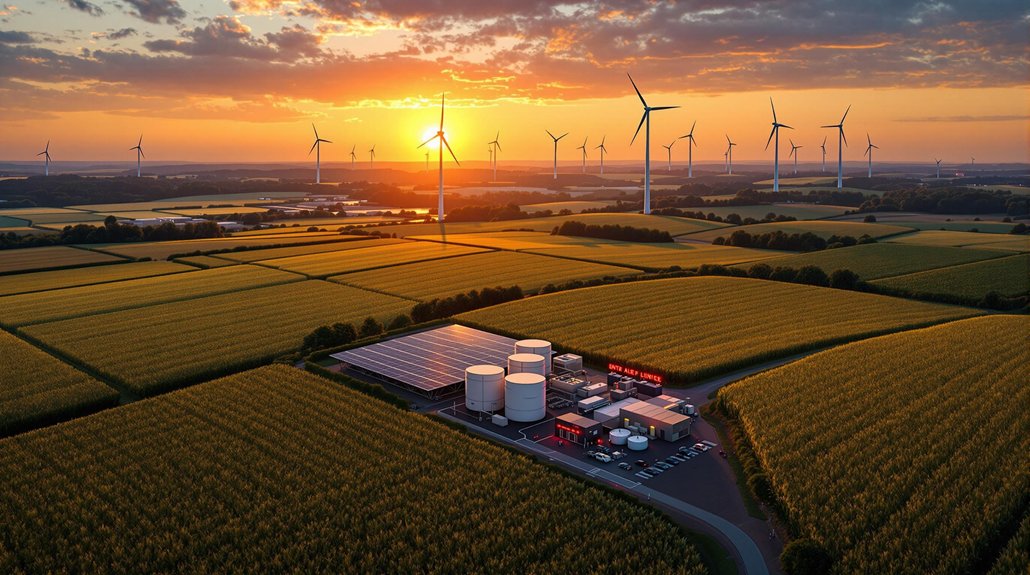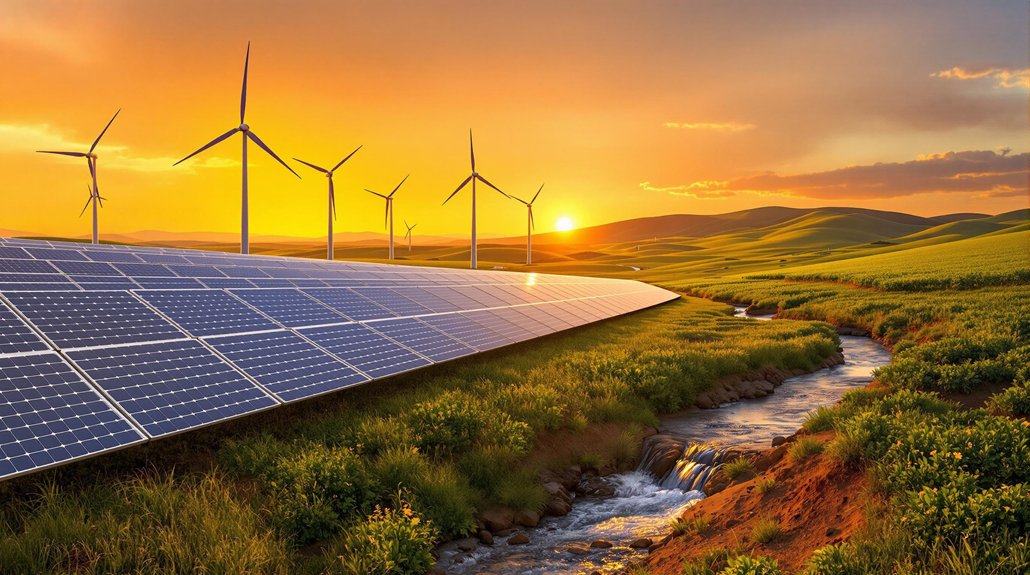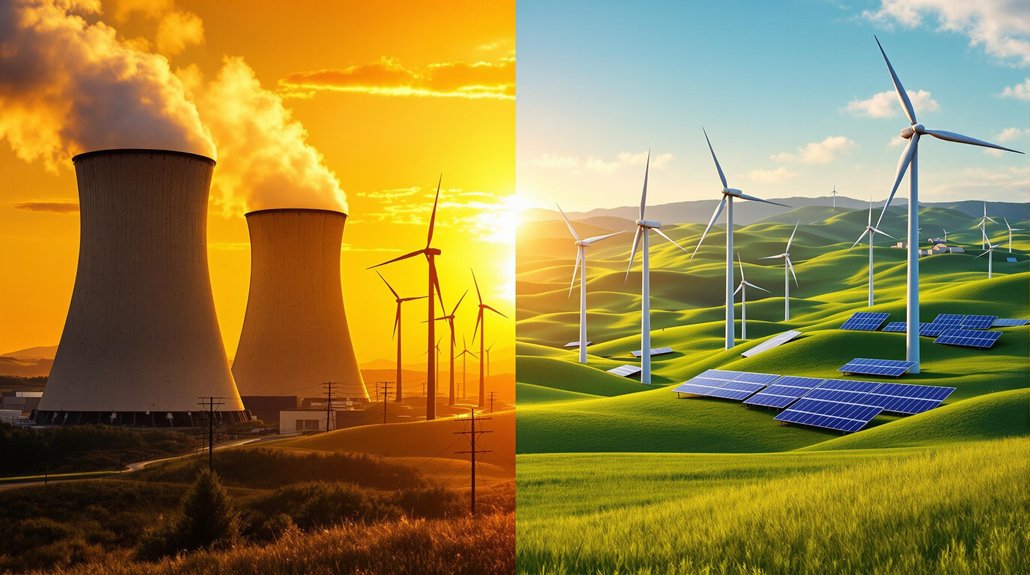By 2035, renewable fuels will dominate the global energy landscape. Wind and solar power will provide 60-80% of electricity, tripling current capacity. The biofuels market will exceed $250 billion by 2025, with renewable diesel and aviation fuel capacity surpassing 57 million tonnes. Government policies target 90% clean electricity, creating 530,000 jobs annually. The shift promises $400 billion in health savings and $1.2 trillion in climate damage prevention. Further details reveal even more impressive projections.

As the world races to combat climate change, renewable fuels are set to dominate the global energy landscape by 2035. Wind and solar power will lead this change, providing 60-80% of electricity generation. Overall capacity is expected to triple from 2020 levels, with a combined 2 terawatts of wind and solar power online by 2035.
The biofuels sector will see remarkable growth. Global renewable diesel and sustainable aviation fuel (SAF) capacity will exceed 57 million tonnes by 2035, growing at 8.5% annually between 2025-2035. The ethanol market will top $150 billion, with the US, Brazil, and India producing over 70% of global supply. The entire biofuels market will pass $250 billion by 2025. Renewable diesel’s high lubricity will continue to drive commercial adoption due to extended vehicle component lifespans. US biofuel production is projected to increase by 53% by 2035, driving global growth in this sector.
SAF is emerging as a critical renewable fuel. Its market will grow at over 15% annually from 2025-2035. US production will jump from just 1,700 barrels per day in 2023 to 190,000 barrels daily by 2035. Even conservative estimates project 110,000 barrels per day by 2035. Airlines and fuel producers are making SAF integration a priority.
Government policies are driving this shift. Federal standards target 55% clean electricity by 2025, rising to 90% by 2035. Unlike fossil fuels, these renewable sources are naturally replenished on a human timescale, making them inherently sustainable. Tax credits for clean energy production and investment will continue, with new incentives for battery storage technologies.
To support renewable growth, transmission infrastructure will expand dramatically. Between 1,400 and 10,100 miles of high-capacity lines will be built annually from 2026, increasing total capacity up to three times current levels.
The economic and environmental benefits are substantial. While the shift to 100% clean electricity by 2035 will cost $330-740 billion, it will avoid 130,000 premature deaths, saving nearly $400 billion in health costs. Climate damage savings exceed $1.2 trillion, creating a net benefit of $920 billion to $1.2 trillion.
The renewable energy sector will add 530,000 jobs annually, further boosting the economy.
Frequently Asked Questions
How Will Geopolitical Tensions Impact Renewable Fuel Adoption?
Geopolitical tensions will both accelerate and complicate renewable fuel adoption.
Nations are racing to secure critical minerals and technology leadership, driving innovation but creating supply chain vulnerabilities. China’s dominance in manufacturing threatens Western energy security goals.
While renewables offer energy independence, new interdependencies are forming around materials and technology. Countries that master renewable production will gain significant advantages in the emerging clean energy landscape.
Can Existing Infrastructure Handle Renewable Fuel Distribution?
Existing infrastructure can’t fully support renewable fuel distribution.
America’s vast pipeline network was built for fossil fuels, creating significant challenges. Ethanol can’t use petroleum pipelines, biodiesel needs special handling, and hydrogen damages steel pipes.
The government’s investing billions in alternatives, including $7.5 billion for EV charging stations and $8 billion for hydrogen hubs.
Solutions include blending renewable fuels with petroleum and repurposing natural gas pipelines.
Will Renewable Fuels Cause Food Price Increases?
Research shows renewable fuels will likely cause some food price increases. The Renewable Fuel Standard has already increased corn prices by 12% in 2019, costing consumers 0.1% more for groceries.
Livestock farmers face higher feed costs, with losses estimated at $3 billion annually. While technological advances may help offset some increases, food-insecure consumers will feel the greatest impact.
Long-term effects depend on land use, climate change, and policy decisions.
How Are Developing Nations Adapting to Renewable Fuel Transitions?
Developing nations are ramping up renewable energy adoption despite challenges. They’ve doubled renewable capacity in recent years, with China leading investments.
Many countries are implementing feed-in tariffs, forming public-private partnerships, and focusing on decentralized solutions for rural areas.
However, they still face obstacles including high capital costs, limited grid infrastructure, and inadequate access to financing.
Only half of least developed countries have specific renewable energy policies in place.
What New Job Markets Will Emerge From Renewable Fuel Industries?
Renewable fuel industries will create diverse job opportunities by 2035.
Technical positions like solar technicians and wind turbine specialists are expected to grow over 40%.
The field will need sustainability consultants, environmental scientists, and carbon capture specialists.
Financial roles including project developers and policy experts will expand.
Community-focused jobs in urban planning, education, and workforce training will also emerge as the sector develops.









